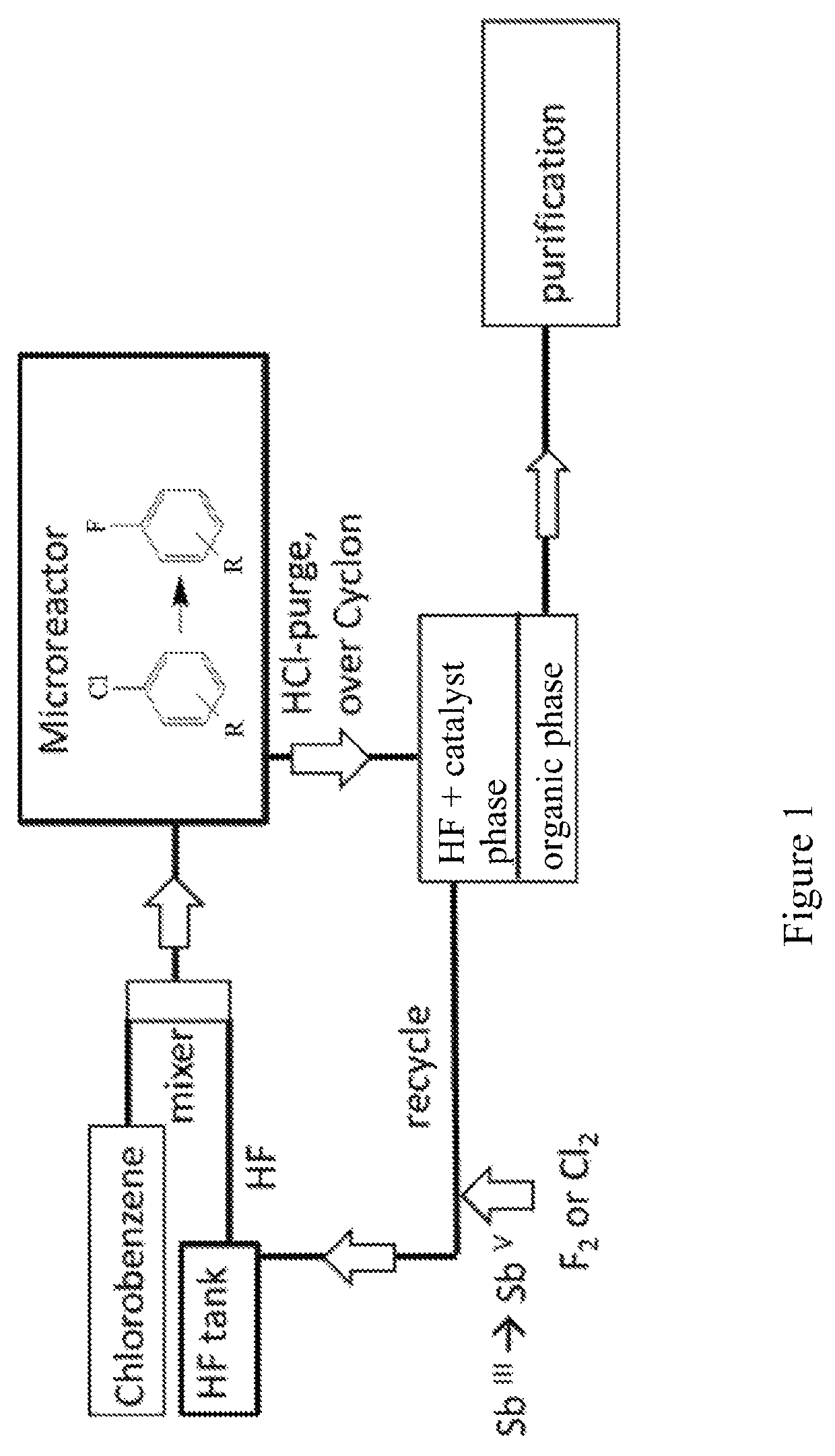Process for the Manufacture of Fluoroaryl Compounds and Derivatives
a technology which is applied in the field of process can solve the problems of limited application of halex reactions, poor efficiency of prior art processes for the manufacture of fluoroaryl compounds and derivatives, and inability to meet the requirements of halogenation, etc., and achieves efficient and energy saving processes.
- Summary
- Abstract
- Description
- Claims
- Application Information
AI Technical Summary
Benefits of technology
Problems solved by technology
Method used
Image
Examples
example 1
Production of Fluorobenzene from Chlorobenzene in the Batch Reactor (Autoclave)
[0185]
[0186]Pre-fluorination of the Catalyst:
[0187]In a 250 ml autoclave from Roth with an inner lining made of HDPTFE, 36.78 g (0.123 mol) of SbCl5 were initially charged, and then it is loaded with 20-times the molar excess of anhydrous HF (2.46 mol, 49.22 g), and the reaction mixture is maintained at 100° C. for a period of 3 h. By this procedure, about 95% of the chlorine atoms bound to the antimony was exchanged by fluorine atoms, and thus, approximately 26.7 g (0.123 mol) of SbF5 are contained in the autoclave as the catalyst.
[0188]Reaction with Chlorobenzene:
[0189]After cooling down, the pressure in the autoclave is released to ambient pressure, and the autoclave containing the pre-fluorinated catalyst is again charged with 49.22 g (2.46 mol) of HF taken from 1 kg HF pressure cylinder that is charged with nitrogen (N2). Subsequently, 27.69 g (0.246 mol) of chlorobenzene are slowly pressed into the ...
example 2
Continuous Production of Fluorobenzene in a Microreactor
[0190]The reaction scheme for this procedure using a microreactor is shown in FIG. 1. In the continuous production of fluorobenzene in a microreactor according to this Example 2, an SiC-microreactor was employed.
[0191]First, batch-wise 500 g (2.31 mol) of SbF5were prepared by the method as described in Example 1 starting from SbCl5. These 500 g of SbF5 were added to the HF-tank along with 462.23 g (23.1 mol) of anhydrous HF in a setup as in the reaction scheme displayed in FIG. 1. The microreactor employed was a Chemtrix microreactor type Protrix made of SiC, and it had a volume of 27 ml.
[0192]Caution: Hastelloy and stainless steel microreactors such as stainless steel 1.7571 cannot be used because they corrode at the latest after 1 h of operation. Also, corrosion reduces the nucleophilicity of the catalyst (strong deactivation by forming SbIII), and thus, the rate of reaction is also reduced.
[0193]Another storage tank is fille...
example 3
Production of 4-fluoronitrobenzene (Autoclave)
[0196]The experiment is repeated as described under Example 1, using 4-chloronitrobenzene as starting material instead of chlorobenzene. The yield of 4-fluoronitrobenzene was 97%.
PUM
| Property | Measurement | Unit |
|---|---|---|
| residence time | aaaaa | aaaaa |
| diameter | aaaaa | aaaaa |
| temperatures | aaaaa | aaaaa |
Abstract
Description
Claims
Application Information
 Login to View More
Login to View More - R&D
- Intellectual Property
- Life Sciences
- Materials
- Tech Scout
- Unparalleled Data Quality
- Higher Quality Content
- 60% Fewer Hallucinations
Browse by: Latest US Patents, China's latest patents, Technical Efficacy Thesaurus, Application Domain, Technology Topic, Popular Technical Reports.
© 2025 PatSnap. All rights reserved.Legal|Privacy policy|Modern Slavery Act Transparency Statement|Sitemap|About US| Contact US: help@patsnap.com



